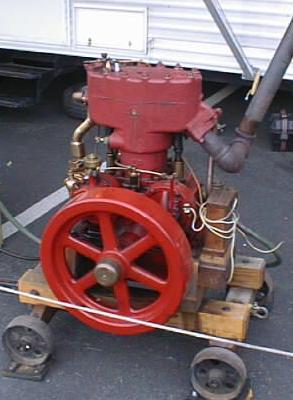|
| Waterlogged Palmer, Can anyone state... |
| Author |
Message |
    
Chris Woodbury
| | Posted on Sunday, April 25, 2004 - 06:01 pm: | 




|
I am very impressed with this site and have spent some hours looking over the goldmine of information. But need some help.
I have dredged up an old Palmer from the creek in front of my house in VA. We are building a Marine Museum here (Deltaville)so I took it over there for some sort of display. I need to know more about it. What model, how many HP (5 or 6)?
Why are there two spark plugs? When was it made?
It was used by one of the long gone watermen who used to crab out of here in the 30's and 40's. when he couldn't use it any more he dumped it in the creek. Been there ever since. Thanks I will Email pictures |
    
Richard Day
| | Posted on Sunday, April 25, 2004 - 07:02 pm: | 




|
Do you have a serial number plate off the engine?
Many Palmer Bros. engines had a letter or letters
cast on the forward lower face of the cylinder or the top of the head in the cast in block models. If you have the serial number the last two digits of the serial number are the year it was made.
Two spark plugs were used so one ran on the magneto and one ran on a battery and model T Ford Buzz coil. In the single cylinder models to keep the production the same for all copies of a particular model they would use two plugs even though they only needed one. Is it a flat head or a dome head engine? Two valves one on each side of the cylinder?? |
    
Olarry
| | Posted on Monday, April 26, 2004 - 12:39 pm: | 




|
You could just put it on a truck and drive up to the calvert show this weekend.You could see the museum and be garented an ID on the engine.I guess you could make solomans in 3 hours or so. |
    
Chris Woodbury
| | Posted on Monday, April 26, 2004 - 05:56 pm: | 




|
Thanks for the first try. Sorry I didn't give much info. It is so badly rusted there is no way to read the letters on the face of the cylinder. There is something there but can't read it. This is a single casting cylinder and head. I guess you call it dome head. This assembly bolts to the lower casting. Exhaust valve on one side and intake on the other (singles). Rods are gone but surprisingly there is a little glass (looks like) strainer down on the base. The water pump is in tact, though full of mud and the excentirc drive is recognizable.
There is a pipe fitting on top of the head which I suppose is part of the compression relief to be opened when starting. Guess my pictures are in the works. Thanks See you at the show. |
    
Ernie
| | Posted on Tuesday, April 27, 2004 - 07:43 am: | 




|
Here are 2 pics. Does it look like one of them. The Blue one is a NL1 and the red one is a ZR1.
Hope this helps
Ernie

 |
    
Chris Woodbury
| | Posted on Wednesday, April 28, 2004 - 06:15 pm: | 




|
Ernie, Thanks, It looks very much like the NL1.
It definately does not have a remvable head. And, the pipe decending from the exhaust lobe has the odd bend in it just like in your picture. I think I was wrong about the use of the pipe fitting coming from beside the spark plugs. It looks to be a cooling line. Is that so?
Anyway I think you have nailed it.
Thnks, Chris |
    
Ernie
| | Posted on Wednesday, April 28, 2004 - 09:01 pm: | 




|
Chris,
Yes that is a water outlet from the top of the cylinder.
Glad to help
Ernie |
    
Ernie
| | Posted on Wednesday, April 28, 2004 - 09:03 pm: | 




|
Oops the pic is an NR1. However a NL1 looks just about identical. |
    
andrew
| | Posted on Thursday, April 29, 2004 - 05:33 pm: | 




|
Here are a couple pictures of the "waterlogged Palmer" from Chris:

 |
    
Richard Day
| | Posted on Thursday, April 29, 2004 - 10:56 pm: | 




|
Looks like a post 1922 Palmer Bros. Cos Cob, CT. model NR-1. This model went out of production in 1929. The switch to a tapered crankshaft and puller nut took place in late 1922. Previous NR engines from 1912 to 1922 had a gib key and straight crankshaft. The bend in the water inlet pipe from the sea water pump was to provide clearance for the exhaust manifold on multiple cylinder models NR-2, NR-3 and NR-4. One can make out the oil pump and line to the site glass over the intermediate gear on forward upper face of the crankcase. The residue of the brass Cuno ignition timer can be seen on the starboard intake camshaft gear housing. The holes visable in the hub of the flywheel were used with the puller nut to remove the flywheel from the tapered end of the crankshaft. One can just make out the top of the brass oil fill plug on the top of the Port exhaust camshaft gear housing. |
|
|
|


|


